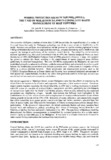Marine protected areas in the Philippines: The case of Malalison island in community-based management of reef fisheries
Share
Abstract
The extensive Philippine coastline of more than 22,540 k m provides the natural habitat of a variety of flora and fauna that make the Philippine archipelago one of the centers of marine biodiversity in the world. Resource-use conflicts, overexploitation, and the pressure to feed the teeming population in many fishing communities have however degraded these habitats, seriously threatening marine biodiversity that supports the biological productivity of the country's coastal fishery. Encouraged by recent enabling national legislation (e.g., the Local Government Code of 1991, the National Integrated Protected Areas System Act of 1992, the Philippine Fisheries Code of 1998), grassroots advocacy in many municipalities has grown to address this threat, resulting in the establishment of marine protected areas (MPAs), particularly in coral reef management. The over 550 MPA s catalogued in the Philippines to date were established primarily to enhance local fishery yields for artisanal fishers and secondarily to protect coastal habitats for biodiversity conservation and multiple economic uses. Enforcement in a majority of these MPAs is a serious problem however. Many government and donor-assisted projects, such as the UNESCO Biosphere Reserves in Puerto Galera and Palawan, have promoted integrated management of both upland and coastal habitats, but these too suffer from persistent conflicts in multiple resource-use and the lack of sustained enforcement by stakeholders.
Our recent experience in Malalison Island, central Philippines describes the efforts of empowering the island fishers themselves to be effective and responsible managers of their marine resources. Grassroots empowerment required organizing the island fisherfolks in 1991 into a working association to promote collective action on a number of local reef fishery management initiatives, particularly the establishment of exclusive-use rights over the island's reef fishing grounds, which entailed influencing the municipal government and neighboring villages. Specific interventions that followed were highlighted by the establishment of a no-take marine reserve and the deployment of concrete artificial habitats in one of their fishing grounds in Gui-ob reef in 1995-1996. Indicators of equity, efficiency, and sustainability suggest that island fisherfolks have gained greater control over their reef fishery resources, allocated their fair share of access rights, and influenced the formulation of fishery co-management policies through direct participation. In the process of empowerment, the island community leaders and many members have become bold and confident in publicly articulating their vision of sustaining harvest from their reef fisheries, a trait that they have not openly displayed prior to 1991. The experience in Malalison Island has demonstrated that fishery co-management, as exemplified by sustained protection of a no-take marine reserve, can be an achievable goal in the Philippines. It may serve as a valuable model to be followed by other coastal fishing communities in Southeast Asia and elsewhere.
Suggested Citation
Garcia, L. M. B., & Primavera, J. H. (2004). Marine protected areas in the Philippines: The case of Malalison island in community-based management of reef fisheries. In Ecosystem Approach in Action in Biosphere Reserves of Southeast and East Asia with Thematic Exchange on Biosphere Reserve in the Context of Large Scale Freshwater Ecosystems: Proceedings of the 1st Workshop of Ecotone Phase II and the 3rd Meeting of Southeast Asian Biosphere Reserve Network (SeaBRnet), Phnom Penh & Siem Reap, Cambodia, 26 October - 1 November 2003 (pp. 137–145). Phnom Penh, Cambodia: UNESCO Office.
Subject
Collections
Related items
Showing items related by title, author, creator and subject.
-
The Status of Fisheries in the Republic of Maldives
Faiz, Mohamed (Training Department, Southeast Asian Fisheries Development Center, 1997)The paper discusses the tuna fisheries in Maldives which dominates its fishing industry. Apart from a very strong domestic market, tuna is also the main export commodity of the country. Moreover, reef fisheries such as, ... -
Status of Fishing Conditions in Cambodia
Sour, Kim; Vuthy, Ros (Training Department, Southeast Asian Fisheries Development Center, 1997)Fisheries in plays a very important role in Cambodia’s national economic development. Total fish catch production in 1996 was 104 310 tones, about which 60% was contributed by inland capture fisheries, 30% by marine capture ... -
Changes in Fishing Activities After the Coastal Zone Management Project
Arnupapboon, Sukchai (Training Department, Southeast Asian Fisheries Development Center, 2007)This paper aims to evaluate the changes in the fishing activities of local fishermen after the implementation of the coastal zone management (CZM) project at Pakklong subdistrict, Pathew District, Chumphon Province by ...





